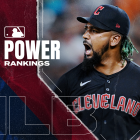Giants ace Madison Bumgarner signed a five-year contract extension worth a guaranteed $35 million in April 2012. It didn't kick in until the start of the 2013 season, and it includes club options for 2018 and '19 that the team will -- without question -- exercise.
In order to get that kind of life-changing money at age 22, which is what Bumgarner did, you must give back enough of a discount in order to allow the team to reap surplus value. That's indeed what happened with Bumgarner and the Giants, to say the least. FanGraphs, using WAR, slaps a dollar figure on each player's season that reflects what said player would've likely fetched on an unfettered free-agent market. In Bumgarner's case, they estimate that he has provided around $140 million worth of free-market value to the Giants over the life of that contract thus far. That contract has paid Bumgarner around $21 million. From the club perspective, that's surplus value in the extreme.
Given Bumgarner's importance to the Giants in the near-, mid- and long-term (bear in mind that the decorated lefty is still 27 years of age) and given that he's already something of a franchise legend, it follows that they would want to lock him up for even longer and perhaps correct the fact that he has been so grossly underpaid for all these years. The way to do that, of course, is to negotiate a new extension that bites deeper into Bumgarner's free-agent years (he has already topped six years of major-league service time) and better reflects his value to the franchise.
ESPN's Buster Olney, however, reports that progress on a Bumgarner extension has stalled, in part because the new collective bargaining agreement (CBA) pumps the brakes on high payrolls like that of the Giants. Here's a key excerpt from Olney's piece:
The Giants have indicated they want him around for a long time, and want to treat him fairly. But Bumgarner, who told reporters Monday that there has been no progress toward an extension, is just one more player getting squeezed by the new rules in the Collective Bargaining Agreement. The luxury tax threshold was raised only slightly in the first years of the new deal, to $195 million this year, $197 million in 2018 and then $206 million, $208 million and $210 million in 2019-2021.
The luxury tax -- or the competitive balance tax, in the euphemistic parlance of the CBA -- has been around for quite a while, but the penalties are getting steeper. As Olney notes, the thresholds for the luxury tax don't increase all that much under the new CBA, certainly not enough to keep up with salary inflation on the quasi-open market. That's by design, of course, as the luxury tax has nothing to do with competitive balance and everything to do with tamping down labor costs and thus protecting the profits of ownership.
In addition to those artificially low thresholds, the penalties are also getting steeper. Under the new CBA, first-time violators are hit with a 20 percent tax on overages, second-time violators are at 30 percent and it's a 50 percent tax rate for third-time offenders. Those are higher rates than what was in place under the old CBA. Also, there's now another layer of penalties for teams that exceed the threshold by significant amounts. Namely, if you top the cutoff figure in a given year by $20 million-40 million, you get an extra 12 percent tacked onto your existing tax rate. If you exceed the threshold by more than $40 million, then, well ...
And teams that exceed luxury tax threshold by more than $40 million, could find themselves paying as much as 90% in taxes.
— Bob Nightengale (@BNightengale) December 1, 2016
On top of all that, teams that cross that $40 million Rubicon get their top overall draft pick knocked down 10 spots. In other words, MLB's tax system includes strong disincentives when it comes to crossing the threshold for a given year, and it includes downright draconian penalties for blowing past the line by more than $40 million. Those penalties are such that it would be shocking to see any team willing to take such a hit. That, then, amounts to a de facto salary cap, no matter what kind of circumlocution you use in place of the words "salary cap."
As well -- and Olney notes this -- long-term contracts are counted against the tax threshold in terms of their average annual value and not the amount of salary allotted for a given year. By way of unrealistic example, let's say Marv Ballgame signs a two-year, $50 million deal with the Branson Tarantula Hawks that pays him $10 million in year one and $40 million in year two -- a heavily backloaded contract that's commonplace in MLB. That helps the near-term financials for the team, but such a deal would count as $25 million per year for luxury tax purposes. In essence, the tax threshold doesn't care how these contracts are actually negotiated and structured. That, in turn, limits a team's ability to make long-term commitments in the fashion that the market has deemed desirable or at least acceptable to both sides. Olney presents this as a new wrinkle, but according to my parsing of the last CBA it was already in place (note: I ain't no lawyer).
Anyhow, the plausible suggestion is that these structural impediments are keeping the Giants and Bumgarner from striking a viable deal. The Giants indeed figure to be up against the wall when it comes to triggering penalties, and, by design, that will likely keep them from investing in their own product -- even when it comes to the very basic step of keeping an icon in the home creams.
As ever -- and as noted -- salary caps are nothing but a way for owners to protect themselves from the free market. The arguments about parity and competitive balance are just baseless spin. But, if for reasons sufficient unto yourself, you want baseball to have a salary cap, then take heart. MLB has one, even if it travels under an alias. Just ask Madison Bumgarner and the Giants.


















